The cryptocurrency bull market will reach a mid-term peak in the first quarter and set a new high in the fourth quarter.
Authors: Matthew Sigel & Patrick Bush
Translation: Deep Tide TechFlow
Please note that VanEck may hold the digital assets mentioned below.
Before discussing our outlook for 2025, let’s first review the performance of our predictions for 2024. Out of the 15 predictions made at the end of 2023, our self-assessment score is 8.5/15. While a 56.6% accuracy rate is not perfect, it is enough for us to continue to "stay in the game." With Bitcoin (BTC) breaking $100,000 and Ethereum (ETH) surpassing $4,000, 2024 remains a memorable year in the history of cryptocurrency, even if some predictions did not fully materialize.
2024 Prediction Review
In our predictions for 2024, we successfully identified several key trends, including:
The launch of Bitcoin spot ETPs.
The successful completion of the Bitcoin halving.
Ethereum remaining in second place, behind Bitcoin.
Bitcoin reaching an all-time high in the fourth quarter of 2024.
L2 dominating Ethereum activity (though L2 TVL remains below Ethereum).
Stablecoin market capitalization reaching an all-time high.
Decentralized exchange trading volume reaching a new record.
Solana (SOL) outperforming Ethereum (ETH).
Growth in DePIN network adoption.
While some predictions did not fully materialize, the overall trends still validated our analytical direction.
Top 10 Cryptocurrency Predictions for 2025
The cryptocurrency bull market will reach a mid-term peak in the first quarter and set a new high by the end of the year.
The U.S. will further embrace Bitcoin through strategic reserves and policy support.
The total value of tokenized securities will exceed $50 billion.
Daily trading settlement volume of stablecoins will reach $300 billion.
On-chain activity of AI agents will exceed 1 million.
The total locked value (TVL) of Bitcoin second-layer networks will reach 100,000 BTC.
Ethereum's blob space fee revenue will reach $1 billion.
DeFi trading volume will set a new high of $4 trillion, with total locked value reaching $20 billion.
The NFT market will recover, with annual trading volume reaching $30 billion.
The performance of decentralized application (DApp) tokens will gradually catch up with mainstream public chain tokens.
Next, we will delve into the background and logic behind some of these key predictions.
1. The cryptocurrency bull market will reach a mid-term peak in the first quarter and set a new high in the fourth quarter
We believe that the cryptocurrency bull market in 2025 will continue to develop and reach its first peak in the first quarter. At the peak of this cycle, we expect Bitcoin (BTC) to reach approximately $180,000, while Ethereum (ETH) will break $6,000. Other well-known projects like Solana (SOL) and Sui (SUI) may see prices exceed $500 and $10, respectively.
After the first peak, we expect BTC to pull back by 30%, while altcoins may experience a larger decline of up to 60%, reflecting market consolidation in the summer. However, a recovery may occur in the fall, with major tokens regaining momentum and breaking historical highs again before the end of the year. To assess when the market is nearing its peak, we will focus on the following key signals:
- Sustained high funding rates: When traders borrow to bet on BTC price increases, their willingness to pay funding rates exceeding 10% for three months or longer indicates speculative overheating.
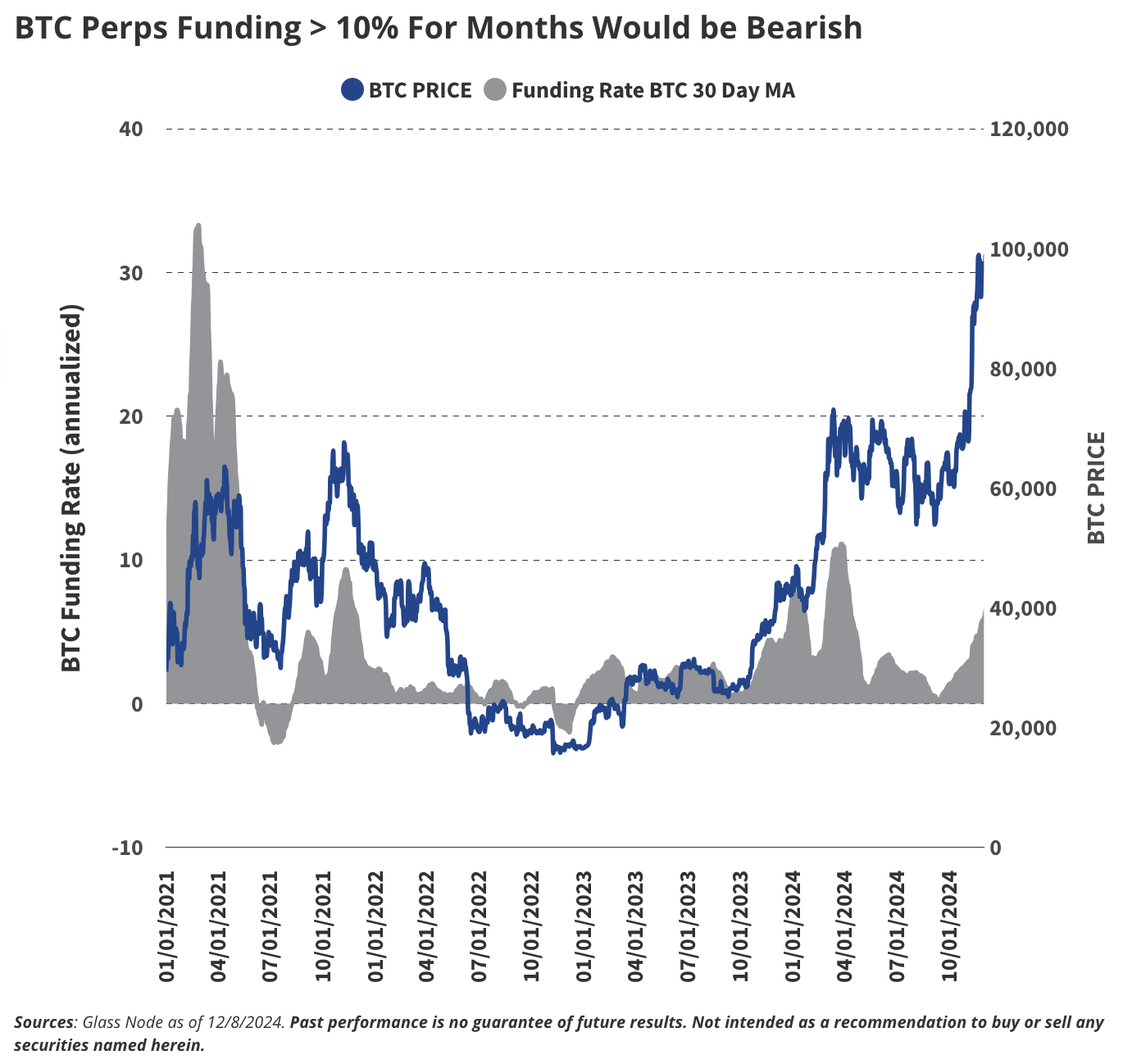
Excess unrealized profits: If a large proportion of BTC holders are in significant unrealized profit (with a profit-to-cost ratio reaching 70% or higher), it indicates market euphoria.
Overvaluation of market cap relative to realized value: When the MVRV (market cap to realized value ratio) score exceeds 5, it indicates that BTC prices are far above the average purchase price, typically signaling market overheating.
Decline in Bitcoin dominance: If Bitcoin's share of the total cryptocurrency market falls below 40%, it means speculative funds are shifting to higher-risk altcoins, which is typical late-cycle behavior.
Mainstream speculation: When a large number of friends from non-crypto fields start inquiring about dubious projects, it is usually a reliable signal that the market is nearing its peak.
These indicators have historically been reliable signals of market euphoria, and they will guide us in formulating our outlook for the 2025 market cycle.

2. The U.S. will further embrace Bitcoin through strategic reserves and cryptocurrency adoption
The election of Donald Trump has injected significant momentum into the crypto market, with his administration appointing several pro-crypto leaders to key positions, including Vice President JD Vance, National Security Advisor Michael Waltz, Secretary of Commerce Howard Lutnick, Secretary of the Treasury Mary Bessent, SEC Chair Paul Atkins, FDIC Chair Jelena McWilliams, and Secretary of Health and Human Services RFK Jr. These appointments not only mark the end of anti-crypto policies (such as the systematic de-banking of crypto companies) but also herald the beginning of a policy framework that positions Bitcoin as a strategic asset.
Crypto ETPs: Physical Creation, Staking, and New Spot Approvals
The new SEC leadership (or possibly the Commodity Futures Trading Commission, CFTC) will approve multiple new spot cryptocurrency exchange-traded products (ETPs) in the U.S., including VanEck's Solana product. The functionality of Ethereum ETPs will expand to include staking, further enhancing their utility for holders, while both Ethereum and Bitcoin ETPs will support physical creation/redemption. The repeal of SEC rule SAB 121 (whether through the SEC or Congress) will pave the way for banks and brokers to custody spot cryptocurrencies, further integrating digital assets into traditional financial infrastructure.
Sovereign Bitcoin Adoption: Federal, State, and Mining Expansion
We predict that by 2025, the U.S. federal government or at least one state (possibly Pennsylvania, Florida, or Texas) will establish Bitcoin reserves. At the federal level, this is more likely to be achieved through an executive order utilizing the Treasury's Exchange Stabilization Fund (ESF), although bipartisan legislation remains an unknown. Meanwhile, state governments may act independently, viewing Bitcoin as a hedge against fiscal uncertainty or a means to attract crypto investment and innovation.
In terms of Bitcoin mining, the number of countries using government resources for mining is expected to reach double digits (currently at seven), thanks to the increasing adoption of cryptocurrencies by BRICS nations. This trend is driven by Russia's plans to use cryptocurrencies for international trade settlements, further highlighting Bitcoin's global influence.
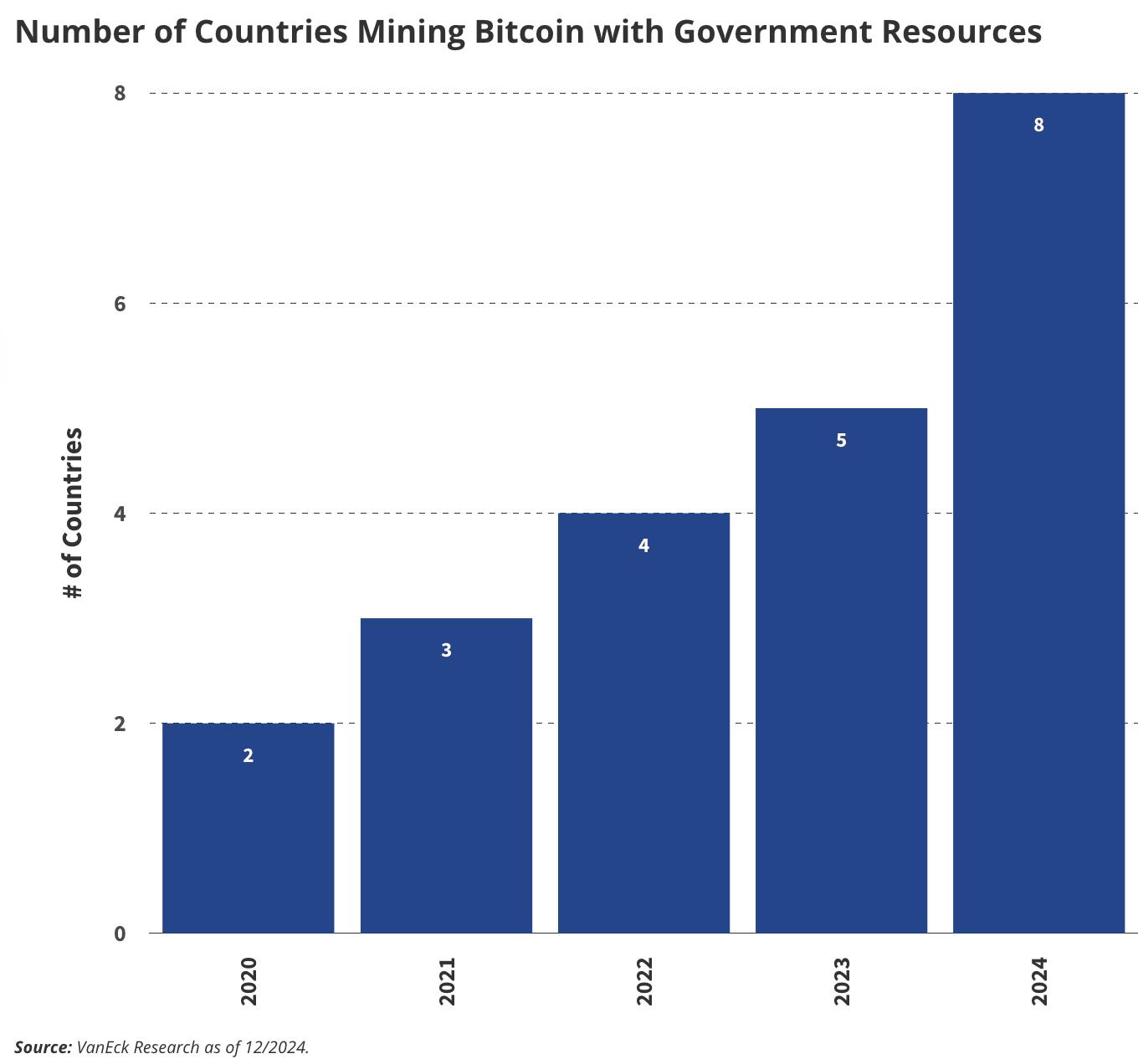
We expect this supportive stance towards Bitcoin to ripple through the broader U.S. crypto ecosystem. With regulatory clarity and incentives attracting talent and companies back, the share of global crypto developers in the U.S. will rise from 19% to 25%. Meanwhile, Bitcoin mining activity in the U.S. will thrive, with its share of global mining power increasing from 28% in 2024 to 35% by the end of 2025, driven by cheap energy and potential tax incentives. These trends will collectively solidify the U.S.'s leadership position in the global Bitcoin economy.
The share of Bitcoin mining power among U.S. public companies will reach 35%
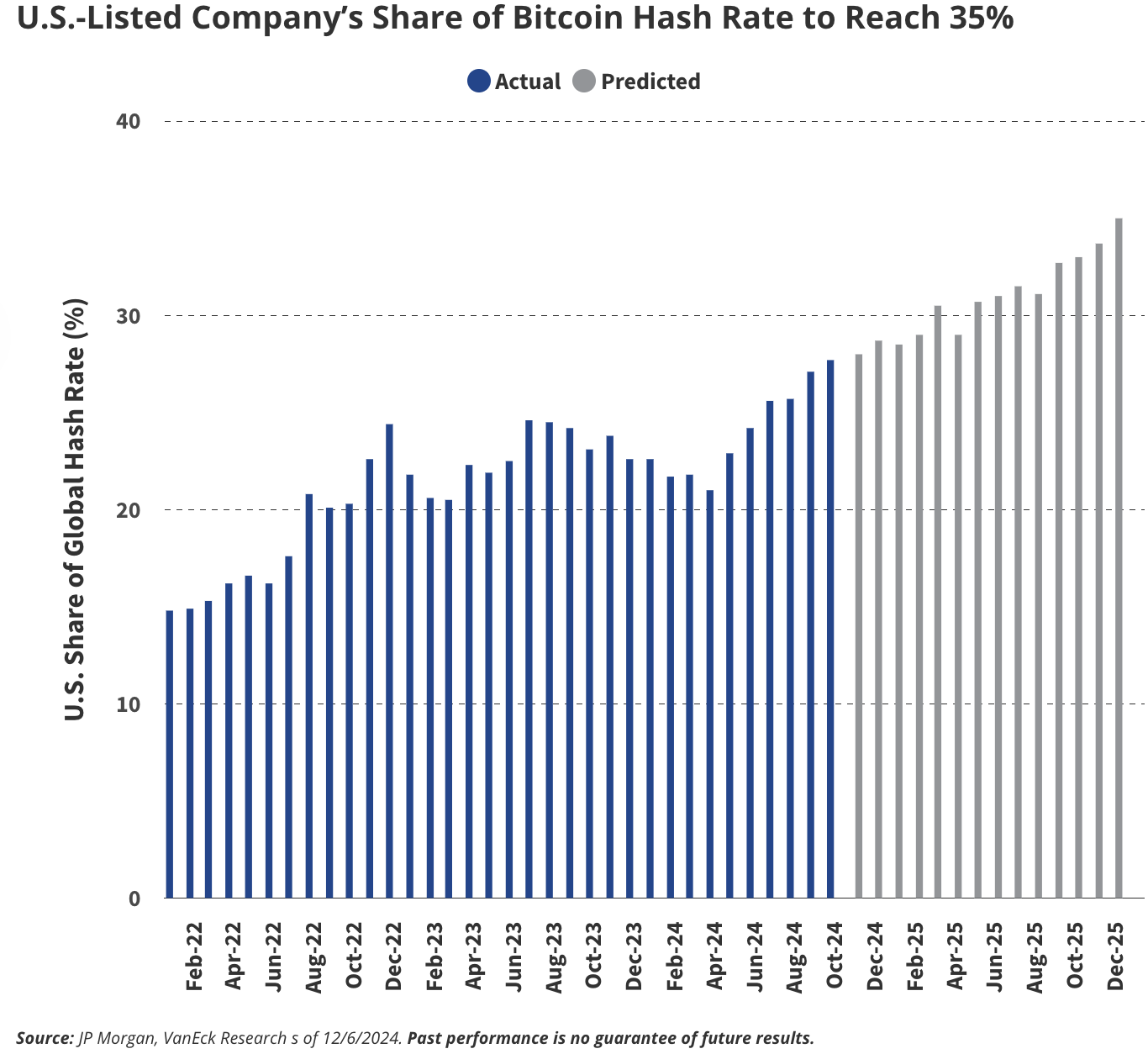
Corporate Bitcoin Holdings: Expected to Grow by 43%
In terms of corporate adoption, we expect companies to continue accumulating Bitcoin from retail investors. Currently, 68 publicly traded companies hold Bitcoin on their balance sheets, and we expect this number to reach 100 by 2025. Notably, we boldly predict that the total amount of Bitcoin held by private and public companies (currently at 765,000 BTC) will exceed the 1.1 million BTC held by Satoshi Nakamoto next year. This means that corporate Bitcoin holdings will achieve a significant growth of 43% over the next year.
Growth Potential for Gold and Bitcoin Ownership: Corporations and Governments
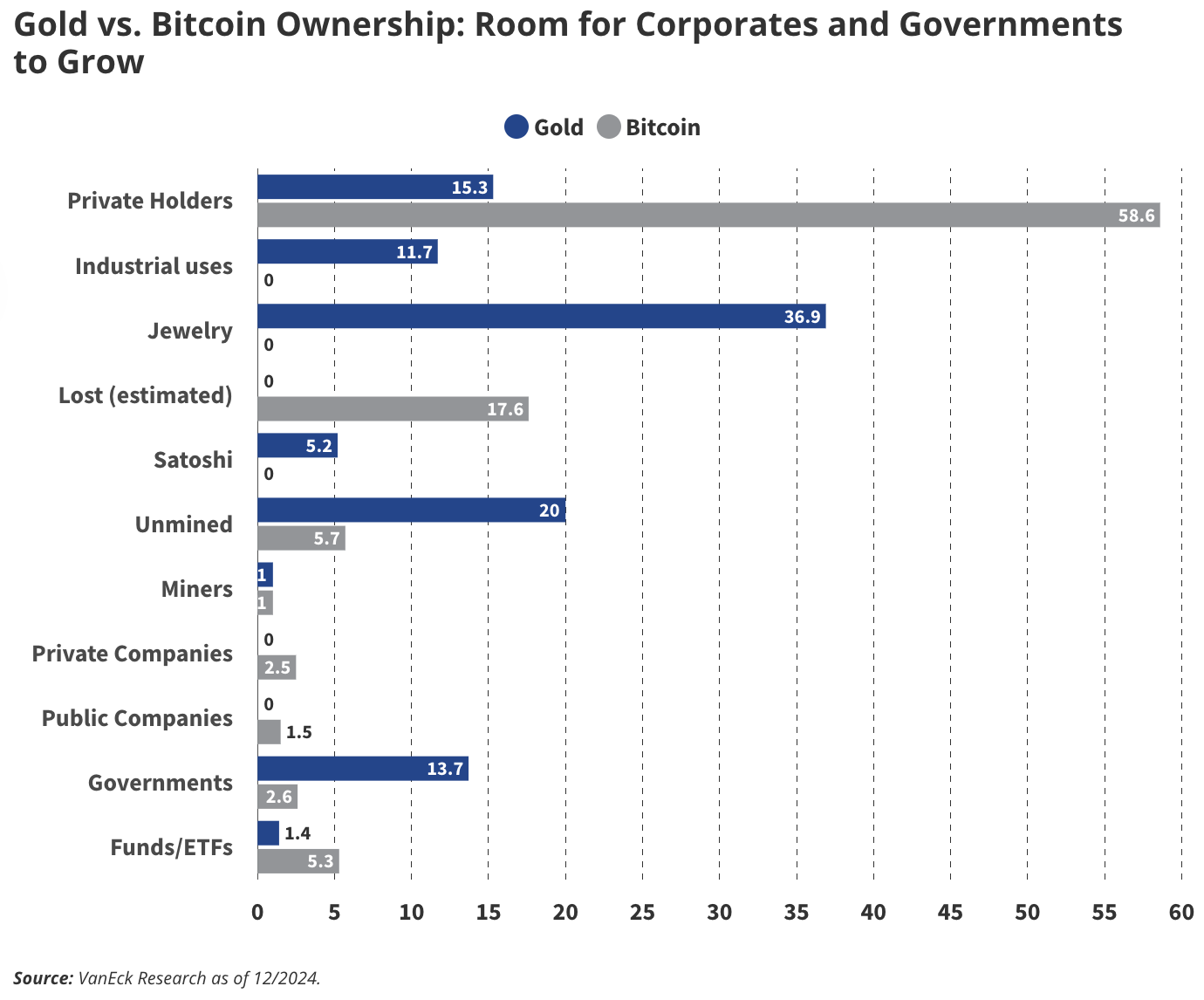
3. The value of tokenized securities will exceed $50 billion
On-chain securities growth of 61% in 2024
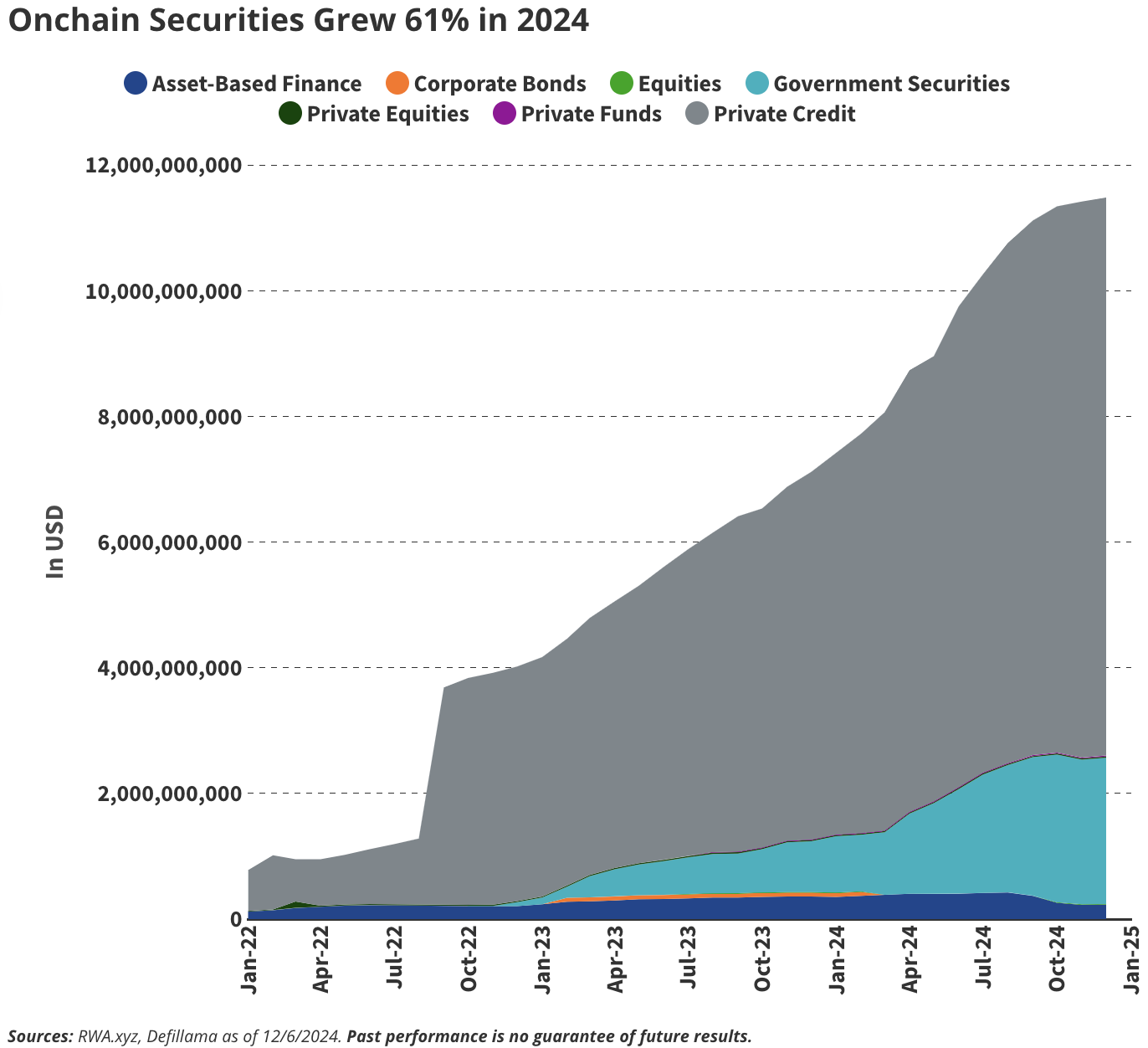
On-chain securities grew by 61% in 2024
The infrastructure of cryptocurrency promises to improve the financial system by enhancing efficiency, decentralization, and greater transparency. We believe that 2025 will be a breakout year for tokenized securities. Currently, there are approximately $12 billion in tokenized securities on the blockchain, with the majority ($9.5 billion) being tokenized private credit securities on Figure's semi-permissioned blockchain, Provenance.
In the future, we see tremendous potential for tokenized securities to launch on public blockchains. We believe that investors have many motivations to drive the complete on-chain issuance of tokenized stocks or debt securities. We predict that entities like DTCC will support the seamless transition of tokenized assets between public blockchains and private closed infrastructures within the next year. This dynamic will facilitate the establishment of AML/KYC (anti-money laundering/know your customer) standards for on-chain investors. As a bold prediction, we expect Coinbase to take unprecedented steps to tokenize its COIN stock and deploy it on its BASE blockchain.
4. Stablecoin daily settlement volume reaches $300 billion
Monthly stablecoin transfers (in USD) grew by 180% year-on-year in 2024
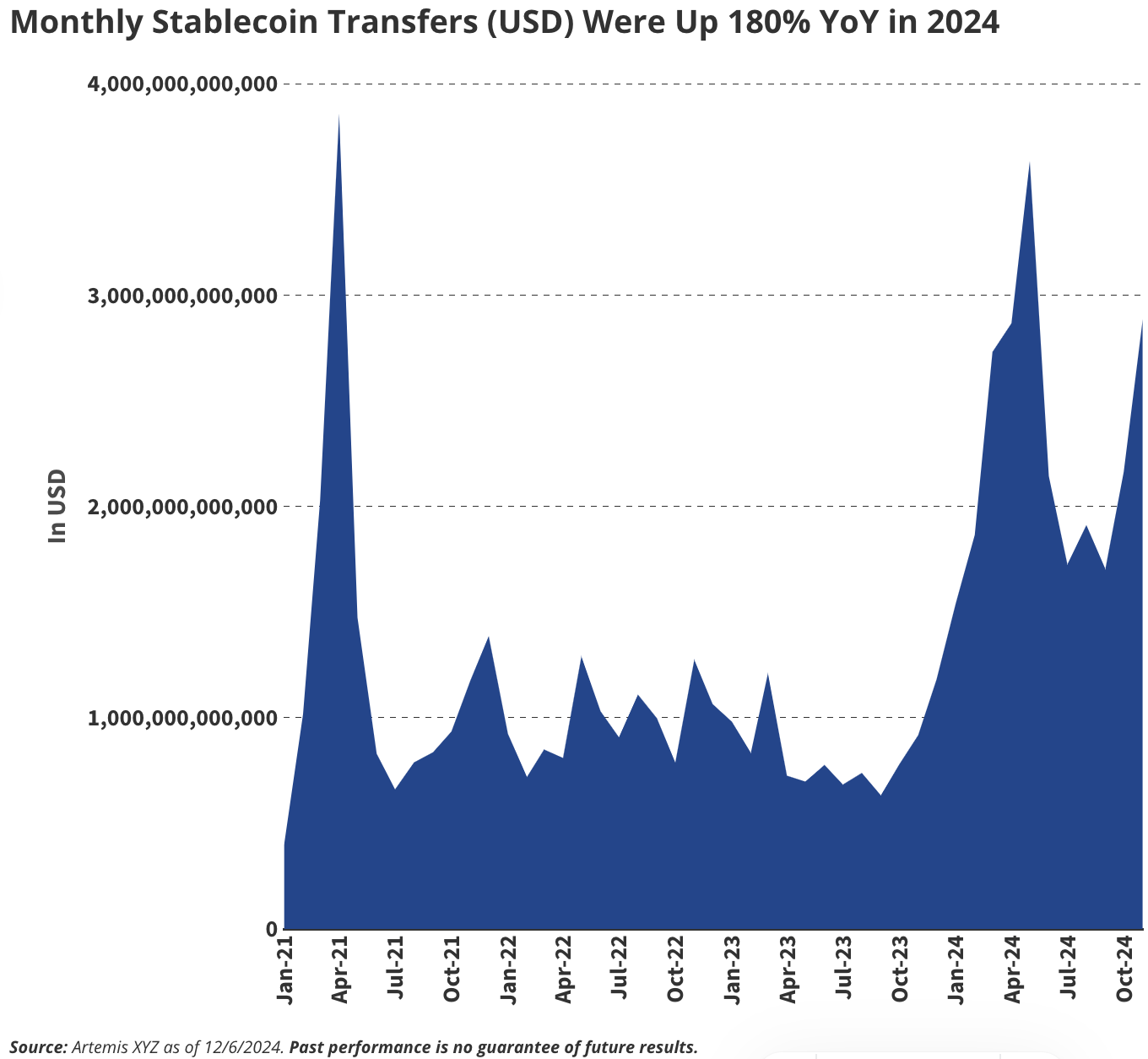
Source: Artemis XYZ, data as of December 6, 2024.
Past performance is not indicative of future results.
Stablecoins will leap from a niche role in cryptocurrency trading to a core component of global commerce. By the end of 2025, we expect the daily settlement volume of stablecoins to reach $300 billion, equivalent to 5% of current DTCC trading volume, while the daily settlement volume in November 2024 was approximately $100 billion. With the adoption of stablecoins by major tech companies (such as Apple and Google) and payment networks (Visa and Mastercard), stablecoins will redefine payment economics.
In addition to trading use cases, the remittance market will also experience explosive growth. For example, stablecoin transfers between the U.S. and Mexico could grow from $8 million per month to $400 million, a fivefold increase. This is due to their speed, cost savings, and the increasing perception of stablecoins as practical tools rather than experimental technologies. Although blockchain adoption is still under discussion, stablecoins are effectively the "Trojan horse" of blockchain technology.
5. On-chain activity of AI agents exceeds 1 million agents
Total revenue of AI agents reached $8.7 million in 5 weeks
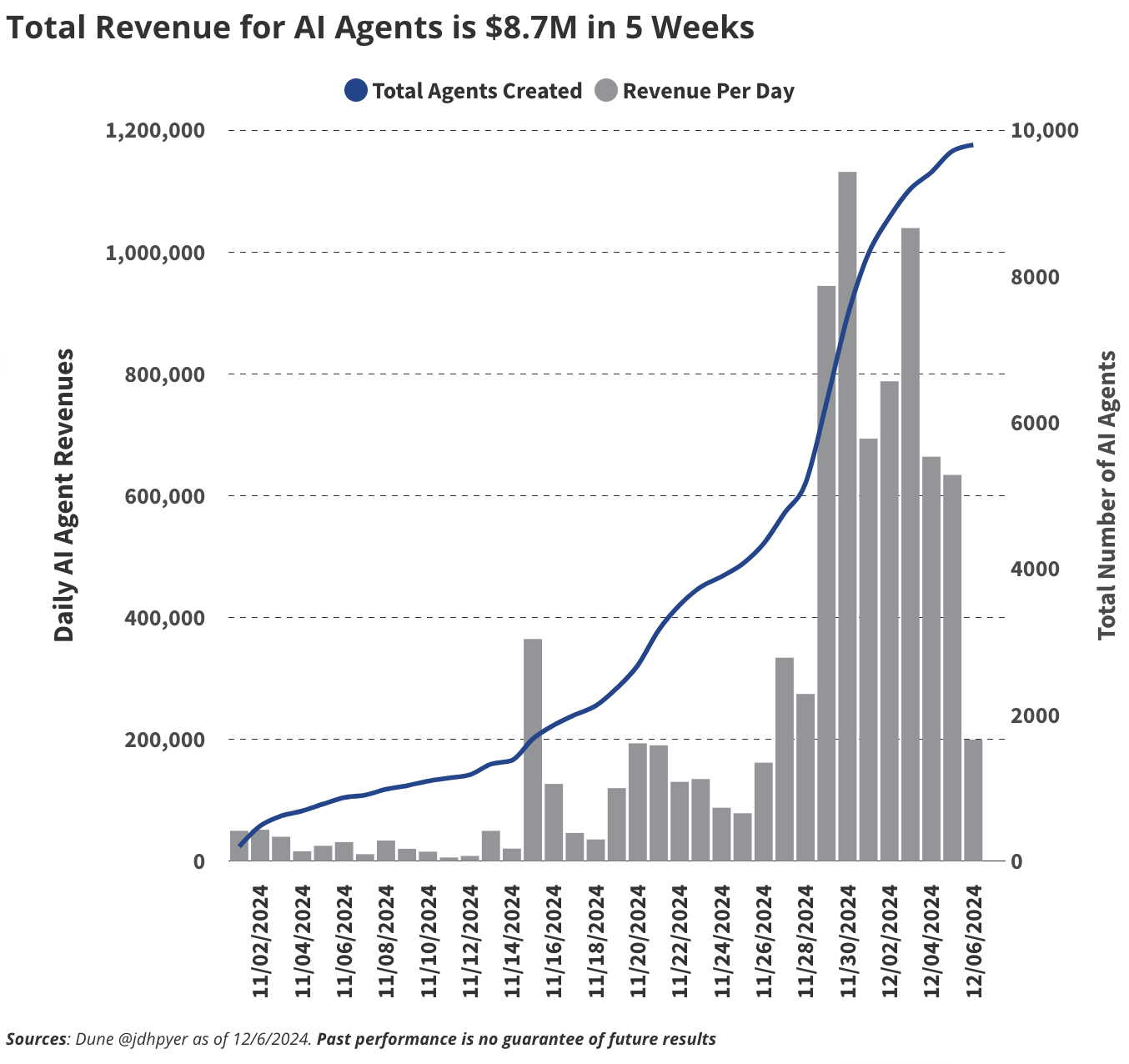
Source: Dune @jdhpyer, data as of December 6, 2024.
Past performance is not indicative of future results.
We believe that AI agents are one of the most compelling trends and will gain significant traction in 2025. AI agents are specialized AI robots that help users achieve goals such as "maximizing returns" or "increasing engagement on X/Twitter." These agents optimize outcomes by autonomously adjusting their strategies. AI agents are typically fed data and trained in a specific domain. Currently, protocols like Virtuals provide tools for anyone to create on-chain AI agents. Virtuals allow non-technical users to access decentralized AI contributors (such as fine-tuning experts, dataset providers, and model developers), enabling ordinary users to create their own agents. This model will lead to a surge of agents whose creators can rent them out to generate income.
Currently, the construction of agents is primarily focused on the DeFi space, but we believe AI agents will extend beyond financial activities. For example, these agents can be used as influencers on social media, virtual players in games, and interactive assistants or companions in consumer applications. Agents like Bixby and Terminal of Truths have already become significant influencers on X/Twitter, with 92,000 and 197,000 followers, respectively. Therefore, we expect over 1 million new agents to emerge in 2025.
6. Total locked value (TVL) of Bitcoin second-layer networks (L2) reaches 100,000 BTC
Bitcoin L2's TVL reaches 30,000 BTC, growing 600% year-on-year in 2024
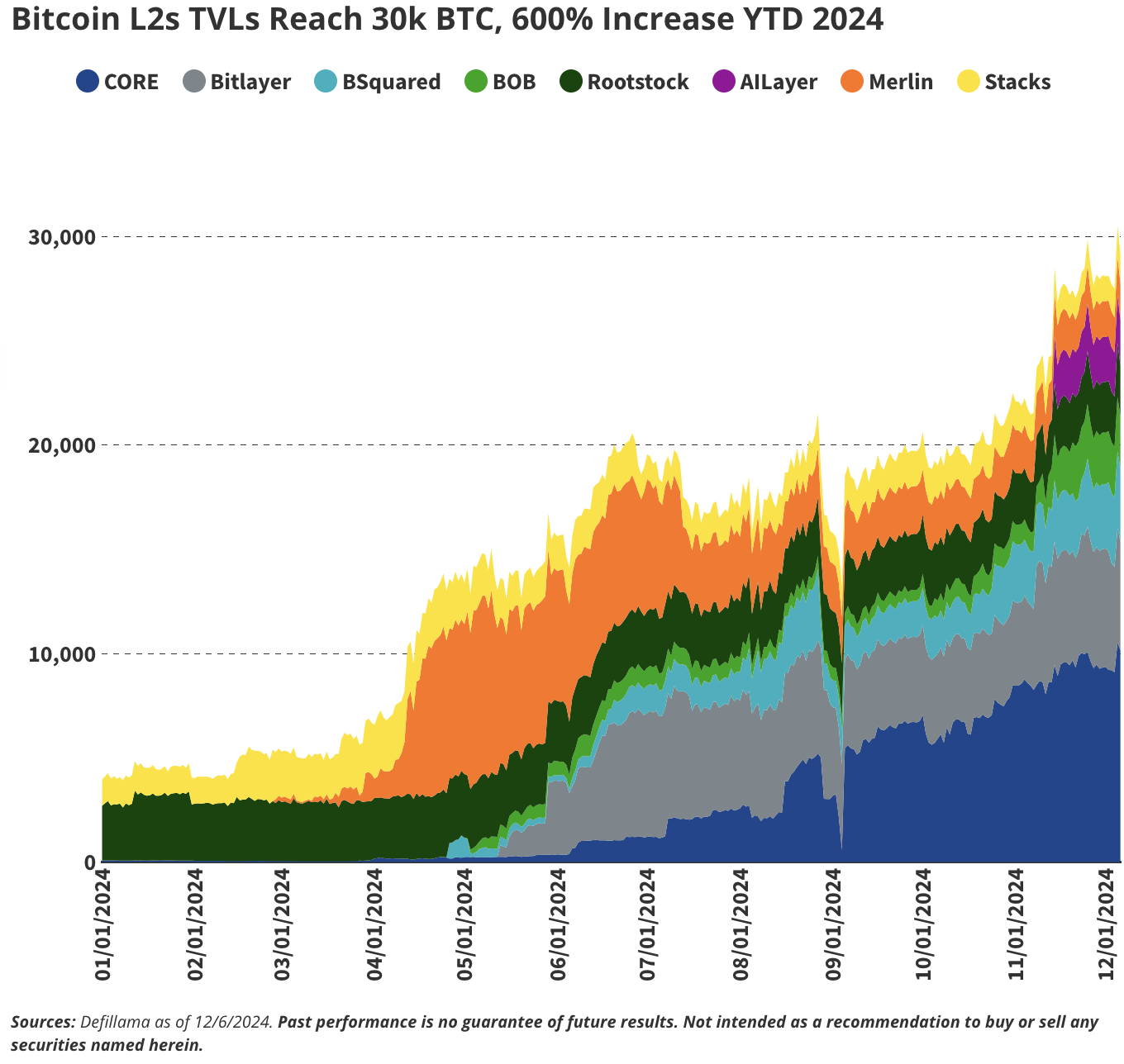
Source: Defillama, data as of December 6, 2024.
Past performance is not indicative of future results. The securities mentioned in this article do not constitute a recommendation to buy or sell.
We are closely monitoring the rise of Bitcoin second-layer (L2) blockchains, which have tremendous potential to transform the Bitcoin ecosystem. By extending Bitcoin's functionality, these L2 solutions can achieve lower latency and higher transaction throughput, addressing the limitations of the Bitcoin main chain. Additionally, Bitcoin L2 enhances Bitcoin's capabilities by introducing smart contract functionality, supporting the decentralized finance (DeFi) ecosystem built around Bitcoin.
Currently, Bitcoin can be transferred to smart contract platforms through bridging or wrapping BTC, but these methods rely on third-party systems, making them vulnerable to hacks and security breaches. Bitcoin L2 solutions aim to mitigate these risks by integrating directly with the Bitcoin main chain, reducing reliance on centralized intermediaries. Although liquidity constraints and adoption barriers still exist, Bitcoin L2 is expected to improve security and decentralization, providing BTC holders with greater confidence to engage more actively in the decentralized ecosystem.
As shown, Bitcoin L2 solutions experienced explosive growth in 2024, with total locked value (TVL) exceeding 30,000 BTC, a 600% year-on-year increase, equivalent to approximately $3 billion. Currently, there are over 75 Bitcoin L2 projects in development, but only a few may achieve significant adoption in the long term.
This rapid growth reflects the strong demand from BTC holders for yield generation and broader asset utility. As chain abstraction technology and Bitcoin L2 gradually mature into products available to end users, Bitcoin will become an important component of DeFi. For example, platforms like Ika on Sui or Infinex using chain abstraction technology on Near demonstrate how innovative multi-chain solutions can enhance Bitcoin's interoperability with other ecosystems.
By supporting secure and efficient on-chain lending, borrowing, and other permissionless DeFi solutions, Bitcoin L2 and abstraction technologies will transform Bitcoin from a passive store of value into an active participant in the decentralized ecosystem. As adoption scales, these technologies will unlock significant potential for on-chain liquidity, cross-chain innovation, and a more integrated financial future.
7. Ethereum blob space fee revenue reaches $1 billion
Daily generation of blob space on Ethereum
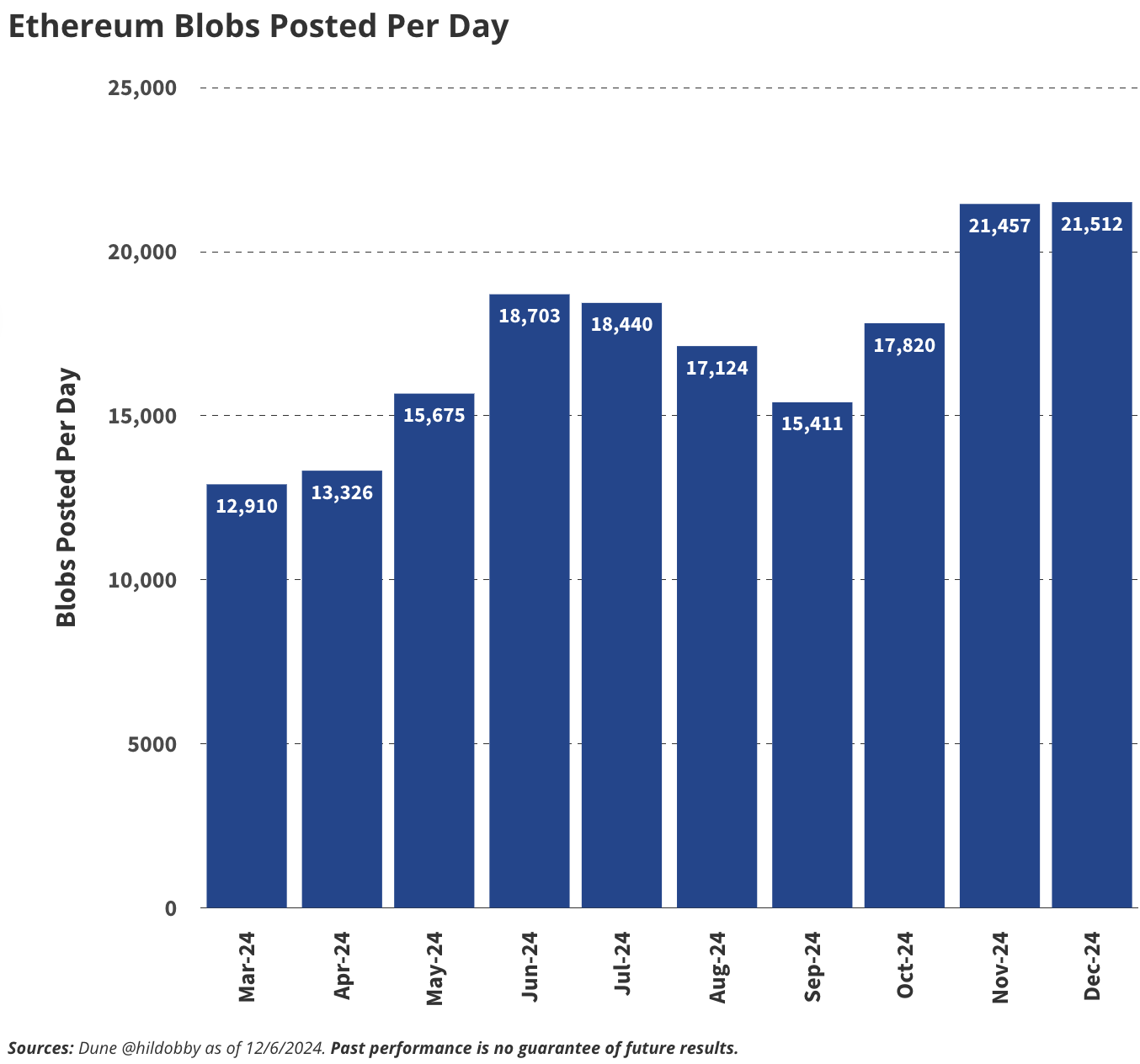
Source: Dune @hildobby, data as of December 6, 2024.
Past performance is not indicative of future results.
The Ethereum community is actively discussing whether its Layer-2 (L2) networks can bring sufficient value to the Ethereum mainnet through blob space. Blob space is a key component of Ethereum's scalability roadmap, serving as a dedicated data layer where L2 can submit compressed versions of their transaction history to Ethereum and pay ETH fees per blob. While this architecture supports Ethereum's scalability, the value paid by L2 to the mainnet is currently low, with a gross margin of about 90%. This raises concerns that the economic value of Ethereum may be overly transferred to L2, leading to a decline in mainnet utilization.
Despite a recent slowdown in blob space growth, we expect its usage to increase significantly by 2025, driven primarily by three major factors:
Explosive adoption of L2: Ethereum L2 transaction volume is growing at an annualized rate exceeding 300%, as users migrate to low-cost, high-throughput environments for DeFi, gaming, and social applications. As more consumer-facing dApps emerge on L2, more transactions will flow back to Ethereum for final settlement, significantly increasing demand for blob space.
Optimizations in rollup technology: Advances in rollup technology (such as improved data compression and reduced costs for submitting data to blob space) will encourage L2 to store more transaction data on Ethereum, unlocking higher throughput without sacrificing decentralization.
Introduction of high-fee use cases: The rise of enterprise-level applications, zk-rollup-based financial solutions, and tokenized real-world assets will drive high-value transactions that prioritize security and immutability, thus being willing to pay blob space fees.
By the end of 2025, we expect blob space fees to exceed $1 billion, which is currently negligible. This growth will solidify Ethereum's role as the final settlement layer for decentralized applications while enhancing its ability to capture value from the rapidly expanding L2 ecosystem. Blob space will not only expand the network but also become an important revenue source for Ethereum, balancing the economic relationship between the mainnet and L2.
8. DeFi sets a new record: DEX trading volume reaches $4 trillion, TVL reaches $20 billion
Total locked value (TVL) in DeFi
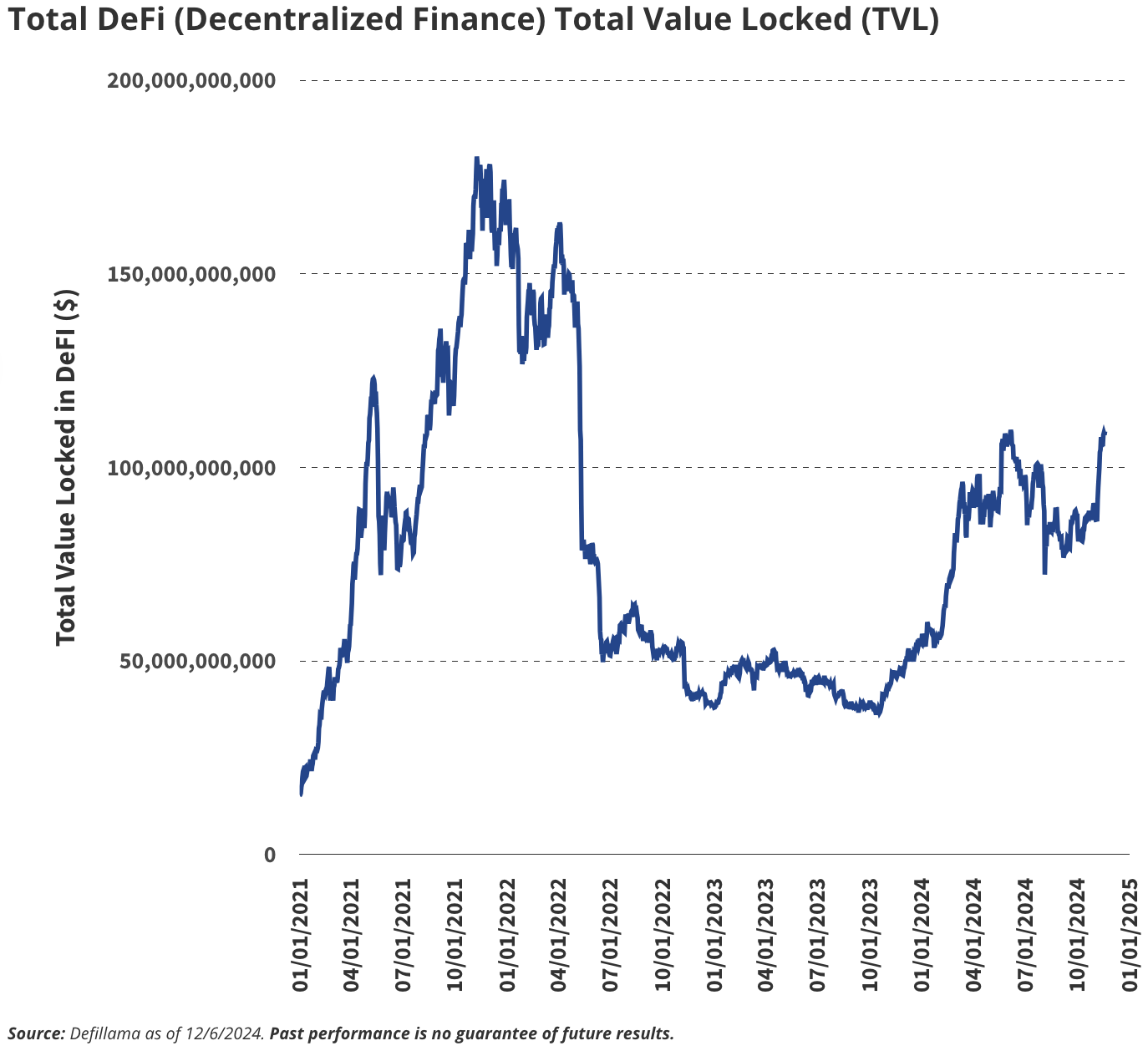
Source: Defillama, data as of December 6, 2024.
Past performance is not indicative of future results.
Despite decentralized exchanges (DEX) achieving record trading volumes both in absolute terms and relative to centralized exchanges (CEX), the total locked value (TVL) in decentralized finance (DeFi) remains 24% lower than its historical peak. We expect DEX trading volume to exceed $4 trillion in 2025, accounting for 20% of CEX spot trading volume, driven by the popularity of AI-related tokens and the emergence of new consumer-facing dApps.
Additionally, the influx of tokenized securities and high-value assets will act as a catalyst for DeFi growth, bringing new liquidity and broader use cases to the ecosystem. Therefore, we anticipate that the total locked value (TVL) in DeFi will rebound to over $200 billion by the end of the year.
This growth not only reflects a recovery in decentralized finance but also signifies its enhanced position within the global financial system. By introducing more user-friendly dApps and innovative financial tools, DeFi will attract new capital inflows, solidifying its status as an alternative to traditional finance.
9. NFT Market Recovery: Trading Volume Reaches $30 Billion
NFT trading volume declined in 2024; we expect a rebound in 2025
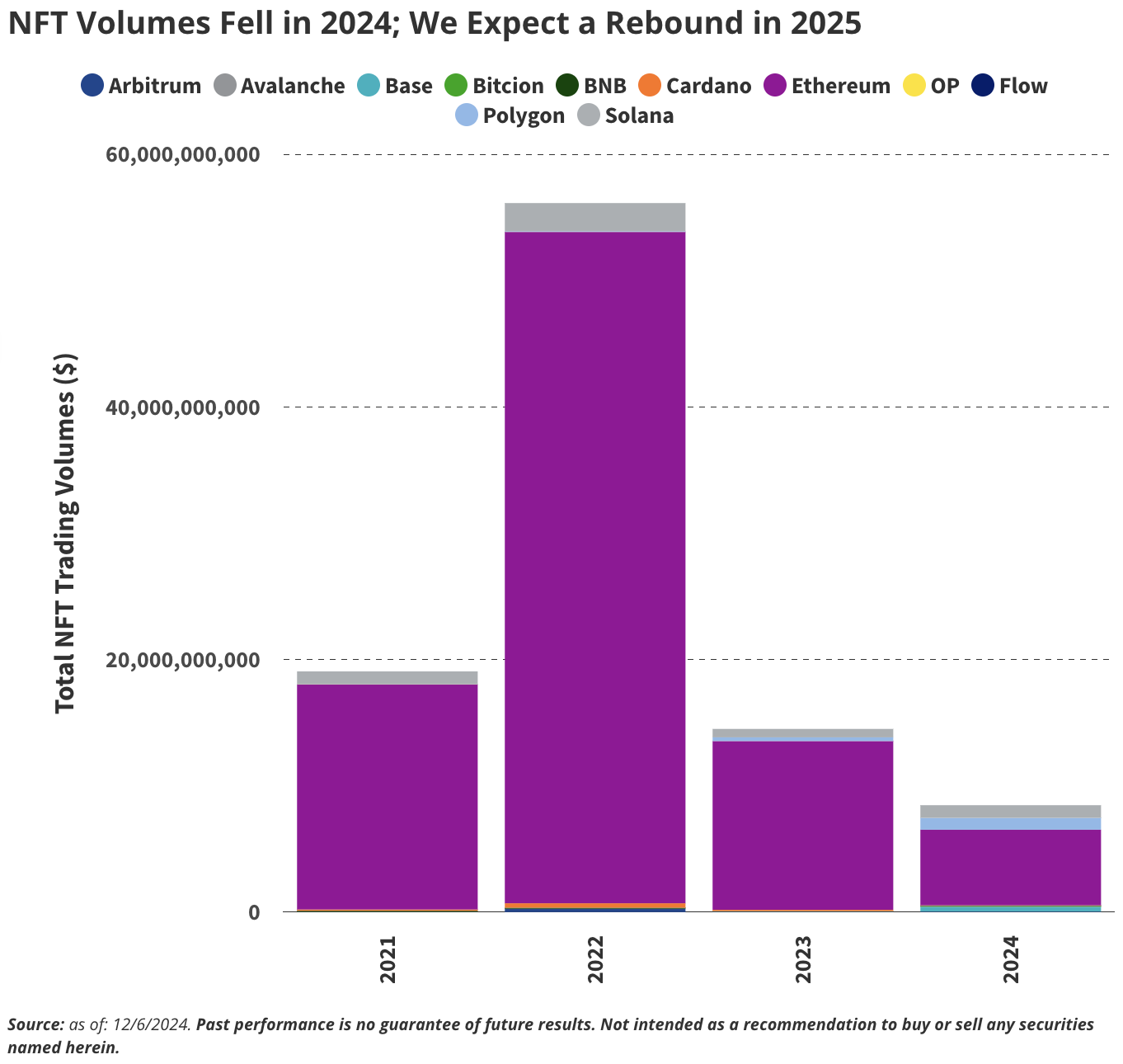
Source: Data as of December 6, 2024.
Past performance is not indicative of future results. The securities mentioned in this article do not constitute a recommendation to buy or sell.
The bear market of 2022-2023 severely impacted the NFT space, with trading volume declining by 39% since 2023 and plummeting 84% compared to 2022. Although the prices of fungible tokens began to recover in 2024, most NFTs continued to lag until November, when they finally saw a turning point after a period of weak prices and low activity. Despite these challenges, some projects with strong community ties have thrived by transcending speculative value.
For example, Pudgy Penguins successfully transformed into a consumer brand through collectible toys, while Miladys gained cultural influence in the realm of internet culture. Similarly, the Bored Ape Yacht Club (BAYC) continues to evolve as a dominant cultural force, attracting widespread attention from brands, celebrities, and mainstream media.
As crypto wealth rebounds, we expect new affluent users to diversify their investments in NFTs, not only as speculative investments but also as assets with lasting cultural and historical significance. Established collections like CryptoPunks and Bored Ape Yacht Club (BAYC) will benefit from this shift due to their strong cultural influence and relevance. Although trading volumes for BAYC and CryptoPunks remain 90% and 66% lower than their historical peaks (in ETH), respectively, prices for other projects like Pudgy Penguins and Miladys have already surpassed their previous highs.
Ethereum continues to dominate the NFT space, hosting the majority of significant collections. In 2024, Ethereum accounted for 71% of NFT trading volume, and we expect this share to rise to 85% in 2025. This dominance is also reflected in market capitalization rankings, with Ethereum-based NFTs occupying all top 10 positions and 16 out of the top 20, highlighting Ethereum's central role in the NFT ecosystem.
While NFT trading volumes may not return to the frenzied highs of previous cycles, we believe an annual trading volume of $30 billion is feasible, approximately 55% of the peak in 2021. The market is shifting from speculative hype to sustainability and cultural relevance.
10. dApp Tokens Narrow Performance Gap with L1 Tokens
In 2024, Layer 1 tokens outperformed major dApp tokens by two times
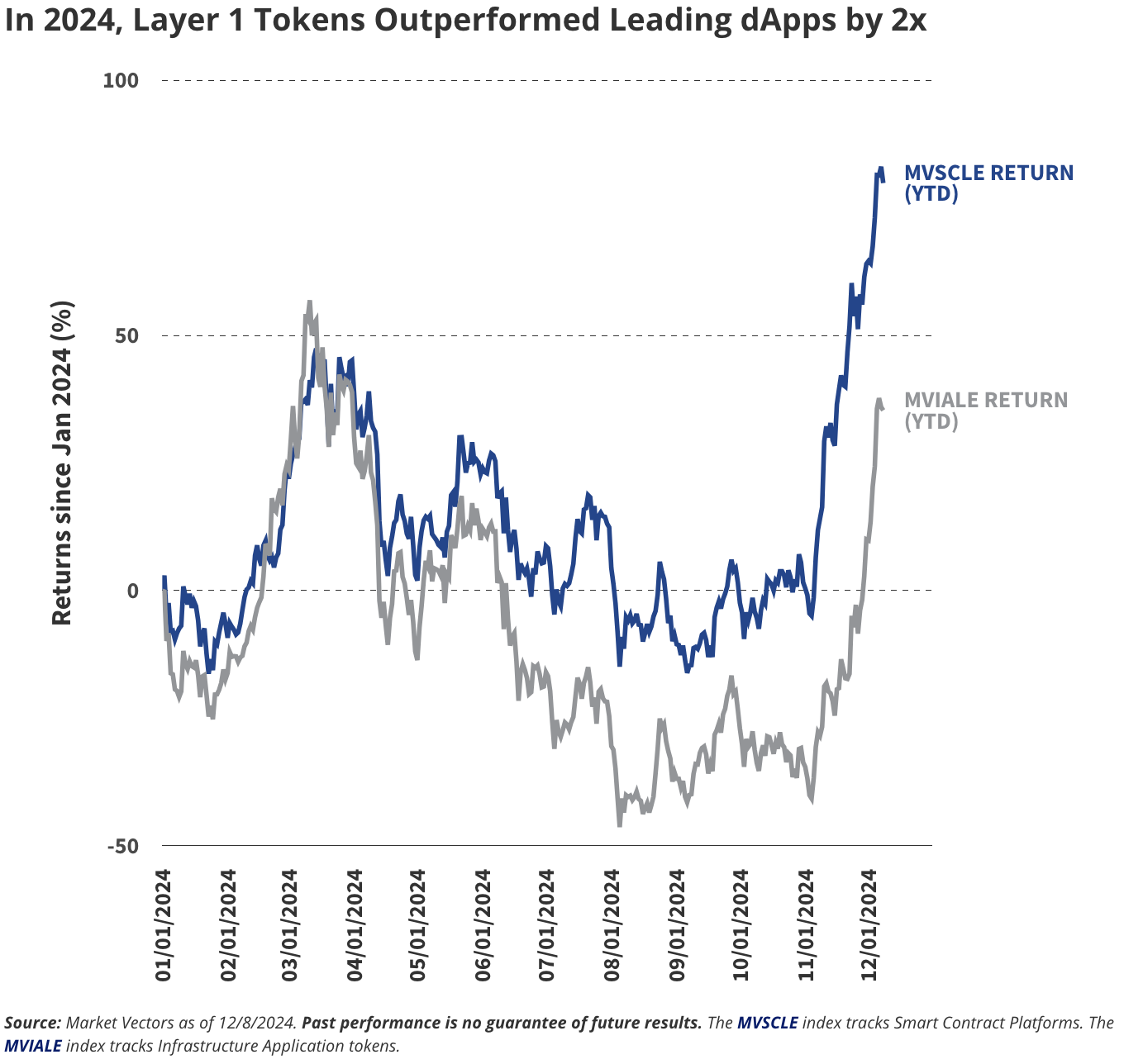
Source: Market Vectors, data as of December 8, 2024.
Past performance is not indicative of future results. MVSCLE index tracks smart contract platforms, while the MVIALE index tracks infrastructure application tokens.
A persistent theme in the 2024 bull market is the significant outperformance of Layer-1 (L1) blockchain tokens relative to decentralized application (dApp) tokens. For instance, the MVSCLE index, which tracks smart contract platforms, has risen 80% year-to-date, while the MVIALE index for application tokens has only increased by 35% during the same period.
However, we expect this dynamic to change later in 2024, as a wave of new dApps will bring innovative and practical products, creating value for their associated tokens. Among key thematic trends, we believe artificial intelligence (AI) is a prominent category in dApp innovation. Additionally, decentralized physical infrastructure network (DePIN) projects also hold significant potential to attract investor and user interest, facilitating a broader performance rebalancing between L1 tokens and dApp tokens.
This shift underscores the importance of practicality and product-market fit in determining the success of application tokens in the ever-evolving cryptocurrency landscape.
免责声明:本文章仅代表作者个人观点,不代表本平台的立场和观点。本文章仅供信息分享,不构成对任何人的任何投资建议。用户与作者之间的任何争议,与本平台无关。如网页中刊载的文章或图片涉及侵权,请提供相关的权利证明和身份证明发送邮件到support@aicoin.com,本平台相关工作人员将会进行核查。




